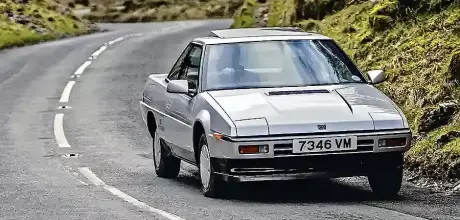1985 Subaru XT
When Fuji Heavy Industries showcased all its automotive technology in the Subaru XT, it unknowingly created the Japanese ‘evo’ car as we know it. We drive the UK’s only remaining roadworthy manual example.
Words SAM DAWSON
Photography JAMES PARDON
The Godfather
Was the misunderstood Subaru XT Japan’s first high-tech ‘evo’ car? Subaru XT survivor: oddball, or the first Japanese techno-wonder?
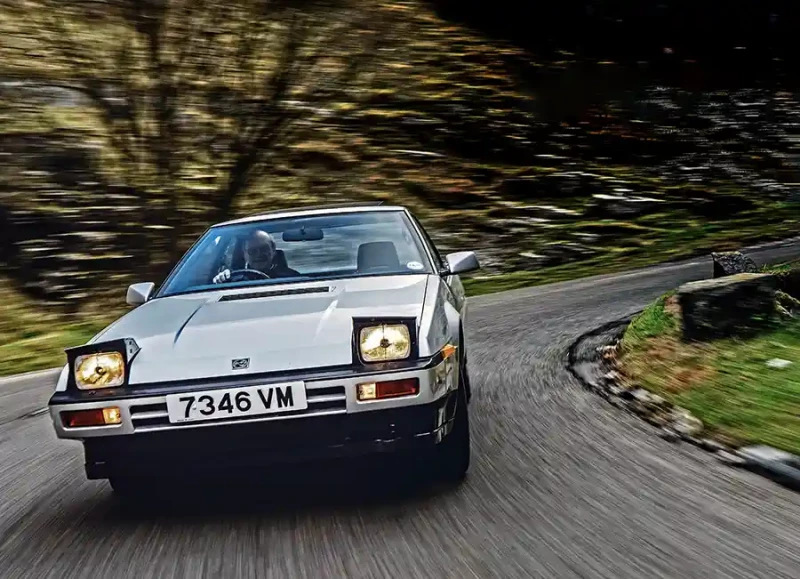
Weird, isn’t it? The shock of encountering a Subaru XT never really lessens despite the passage of nearly 40 years. The way it looks disconcerts you first – with nothing like metallic blue paint and gold wheels to make it obvious, you’ll swear you’ve seen an Eighties concept car rather than anything sold in a showroom. When your brain cycles through possibilities as to what it could be, it’ll alight at Michelotti’s Ferrari 400 Meera or Giugiaro’s Lotus Etna before it gets to anything made on a production line.
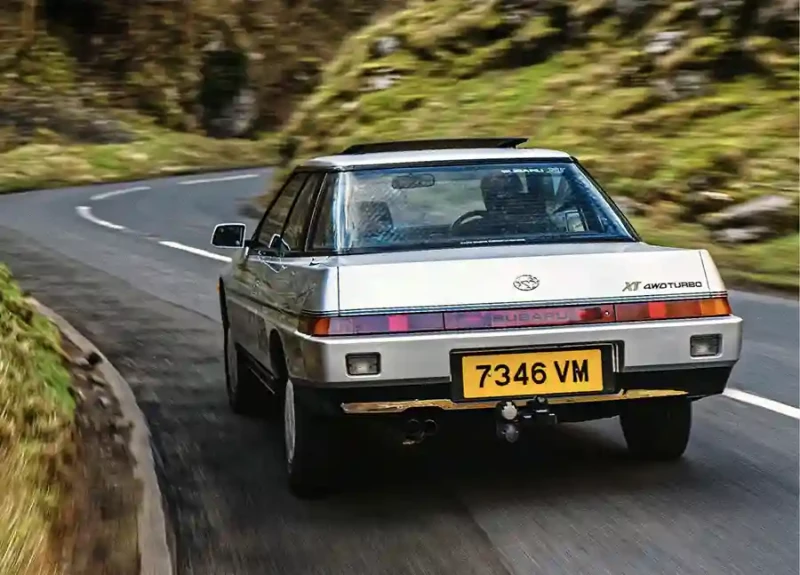
But its jagged angularity doesn’t make it pretty. The suspension seems to sit far too high for something wedgy with pop-up headlights for starters. And that’s before we get to the interior, and a steering wheel with an asymmetrical, two-spoked boss. Nothing about the XT seems to make sense.
Yet imagine being a Subaru engineer in 1985. You spend years creating a technological tour de force, a car intended to be a Japanese Citroën SM or Audi Quattro, and yet the second the motoring press get their hands on it all they can talk about is the fact that, in the automatic example they were given – by a firm that made pickup trucks for farmers and sold them through tractor dealerships – the four-wheel drive system only came on when they activated the windscreen wipers. No, this’ll never catch on, surely? But 39 years later, a cabinet full of rallying silverware suggests Subaru had the last laugh…
Even the doorhandles defy convention. They sit completely flush with the metal, and you have to push a lower flap inwards to get your fingers under the handle itself. And yet, as always with the XT, if you ask why rather than merely writing it off as eccentricity, you’ll come up with the answer: it’s all part of an aerodynamics package that results in a 0.29 drag coefficient. Same goes for the needle-like nose – if it was sniffing the road in the name of downforce it’d also create drag – and the flattened-football wheels, which look like plastic trims but are in reality cleverly-designed alloys.
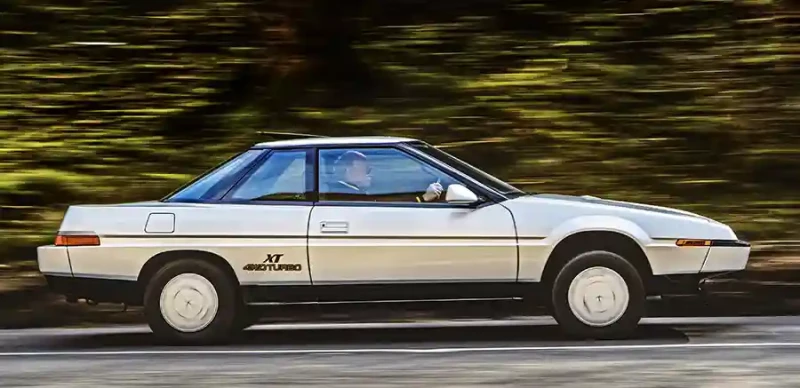
Inside the XT, I’m reminded more of an aeroplane than a car. The glasshouse is pretty-much unrivalled for all-round visibility, and settling in requires pre-flight checks. The steering wheel actually has two separate controls for reach and rake adjustment and, like a Porsche 928, whose famous ‘Pasha’ seat fabric Subaru brazenly copied, the instrument panel hinges with the wheel.
However, it does so more subtly than the German car – the housing stays put, and the gauges tilt within it. Also Germanic is the eccentric reach-and-wipe single windscreen wiper, identical in concept to the contemporary Mercedes-Benz W124’s. The gear lever resembles a joystick complete with four-wheel drive activated by a ‘fire’ button. Banks of auxiliary fingertip switches sprout from the dashboard like handles of a flight yoke.
The engine idles with an undistinguished metallic churn, underlaid with a familiar Subaru throb. The first thing you notice when you get up to B-road speeds, though, is the absence of all other sounds – those aerodynamics work impressively to silence wind noise and the narrow tyres don’t even generate enough road roar to penetrate the cabin. And then, at 2250rpm, a blue turbo icon lights up on the dashboard and a jet-takeoff whoosh sounds under the bonnet. Suddenly, there’s a new, smooth wave of torque to play with, and the XT feels more potent and sporty. Well, provided you can keep it in its power band, that is. The joystick-gearlever is a joy to shift, which is just as well because the engine demands a lot of it. The gear ratios seem strangely spaced, with first and second closely stacked like sprint gears, then third as long and loping as you expect fourth or fifth to be. It’s easy to stray off-boost in third. However, when you knot together a few bends and apply deep analysis once again, you realise you can leave the XT in third, use the turbo-boost like an extra gear, and concentrate on driving it like a sports car, whereupon it springs a remarkable surprise.
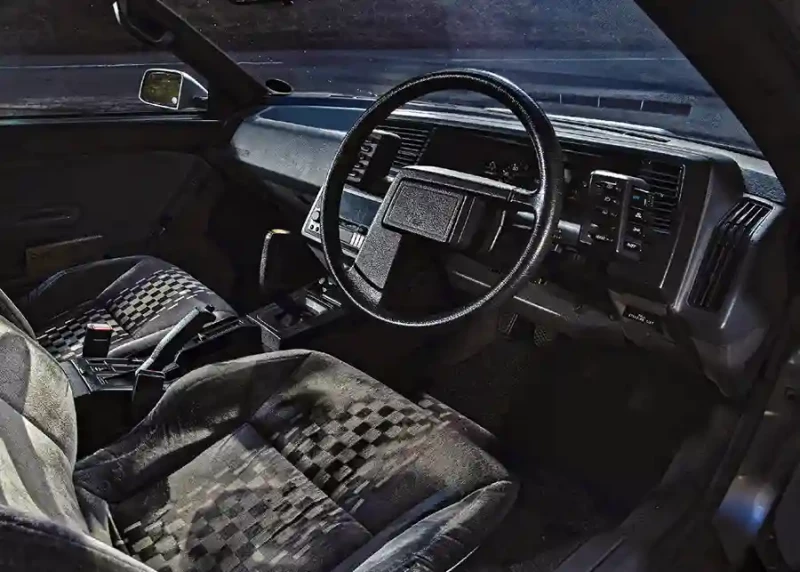
As the XT passes 30mph, its ‘Cybermatic’ steering activates a little clutch at the end of the column that – get this – shifts the pinion to a row of faster-rate teeth on the rack. When you’re at parking speeds it’s as long-winded and twirl-demanding as the Volvos that Subaru saloons rivalled back in the early Eighties. But on B-road attack it’s a 2.5-turn lock-to-lock sports car. This transition disturbed road testers when the car was new and pitted against pie-and-mash fayre like Capri V6s and Starion Turbos, but nowadays it’s precisely the sort of gadgety driver-focused adaptation you’d expect in a high-tech Japanese car.
The steering doesn’t provide granular feedback, but there is a satisfyingly solid, meaty feel that conveys a sense of command. It’s not the only thing that works with you – as I wend through the hairpin bends of Cheddar Gorge, I can feel the XT’s hydropneumatic suspension ‘breathing’ between the cambers to keep the car level while supporting a supremely smooth ride. Heavily servoed yet progressive, the brakes are strong too. It’s on roads like this that the daft-looking steering wheel suddenly makes sense. There’s a little thumb-sized notch on the left that allows you to relax with your hands at quarterto- three, but as the going gets twisty and with the steering on the faster rack, the horizontal spoke becomes a subconscious reference point for three o’clock when you want to centre the car, while your left hand runs around the wheel unencumbered by furniture to add extra leverage when tackling the bends.
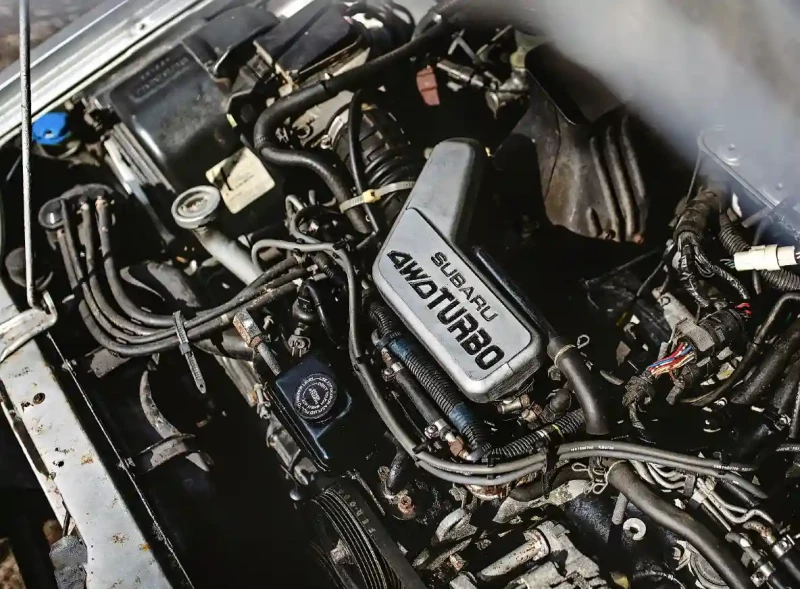
The XT takes on challenging roads with aplomb. Push it hard into tight bends, and while it’s clearly no Porsche – it shifts its weight hard onto its front wheels and pulls with torque rather than pushing itself, revving wildly, out of corners – it’s wellbalanced, with none of the initial plough-on understeer you’d find in an Audi of this era. The reason for this is revealed when you pop the bonnet and see just how low-mounted and far back in the chassis that flat-four is. Then bear in mind that, even if it’s not activated, the weight of the rear differential still helps to balance out the chassis, and the XT drives like a well-poised, yet impeccably refined hot hatch from a later era than its own. The odd thing is, despite being plastered in decals reminding you it’s four-wheel drive, the XT rarely uses it. There’s a reason why the activation switch is an angry orange colour – it’s more an emergency measure than a sporty toy.
The four-wheel drive system and Subaru’s approach to its use is the only thing that really links the XT to Subaru’s agricultural role more familiar to Seventies and Eighties buyers, yet also points to its future. With no centre differential, it’s designed solely to find grip on genuinely loose, slippery surfaces. Activate it on a dry road – as those Eighties road testers did – and it’ll seem positively dangerous, the rear driveshafts winding up with torque and fighting the front end for supremacy. It’s the reason why, on the automatic, it activated along with the windscreen wipers in anticipation of wet roads.

However, the concept of a sporting car that adapts to its terrain at the flick of a switch is yet another characteristic of the musclebound Japanese rally cars which followed in the Nineties, with their drive modes, terrain response settings and configuration menus.
There’s also a hill-hold system, which allows the driver to concentrating on making a smooth getaway rather than juggling handbrake release with revmatching. In another frame of mind, you could call this launch-control. As I end my drive in the XT, I try to put myself back in the mindset of those Eighties road testers who condemned it yet, in retrospect, seem so misguided given what followed. Maybe it was the fact that at the time it was playing in a coupé marketplace that largely prized tailsliding behaviour and macho aesthetics above all else, and the XT was just too great a shock to the system, even given the similarity of concept to the Citroën SM and Audi Quattro?
No, it was something else. Up until this point, the Japanese car industry had been all about imitation and getting the basics right. Throughout the Seventies its cars had looked and felt like copies of European and American ones, offering quality and reliability when such things were lacking in the cars they emulated. As they became more established, they also got more ambitious as they took aim at ever-more iconic designs: the Toyota MR2 bested the Fiat X1/9 in every measurable way. The Mitsubishi Lancer Turbo improved upon BMW’s boosted 2002. Datsun’s 240Z showed the British how to modernise the sports car. Toyota’s Supra gave US muscle an almighty kicking.
But the recipes were still resolutely foreign in concept. With the Subaru XT, the Japanese car industry gave the world something well and truly Japanese. This meant the uniting of the country’s cutting-edge electronics and computing prowess with car design to produce something completely unique. To an Eighties road-tester it was a sudden, unexpected helping of sushi at the chip shop. Nowadays there’s a Wagamama in every town centre.
TECHNICAL DATA 1985 Subaru XT
- Engine 1781cc horizontally-opposed four-cylinder, IHI VF6 turbocharger, Hitachi SPFI electronic fuel injection
- Max Power 136bhp @ 4800rpm
- Max Torque 145lb ft @ 2800rpm
- Transmission Five-speed manual, switchable four-wheel drive
- Steering Power-assisted dual-speed rack-and-pinion Suspension
- Front and rear: independent, MacPherson struts, coil springs, hydropneumatically-controlled telescopic dampers with centralized accumulator sphere, anti-roll bar
- Brakes Servoassisted discs front and rear
- Performance Top speed: 119mph
- Acceleration 0-60mph: 8.7sec
- Weight 1130kg
- Fuel consumption 32mpg
- Cost new £16,000
- Classic Cars Price Guide £6000-£11,000
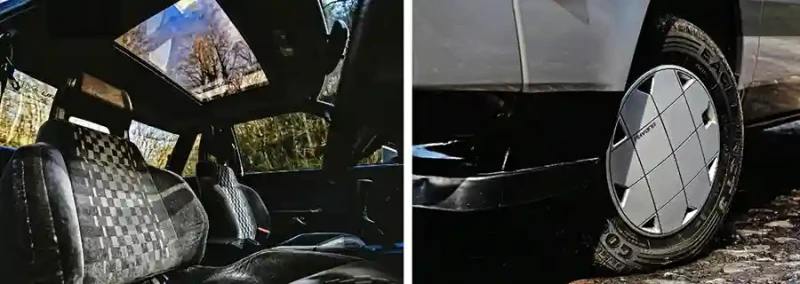
Was this tech showcase first Japanese ‘evo’?
‘You can leave the XT in third, use the turbo-boost like an extra gear, and drive it like a sports car’
Op-art seat fabric echoes Porsche 928’s Aero wheels look like trims, but are alloys.
Turbo flat-four evolved into Impreza engine. Handling reminiscent of much newer car. Unconventional XT baffled ’80s road testers.
‘Flight yoke’ avant-garde switchgear Instruments tilt within the dash binnacle Even when new, buying a UK XT was tricky.
Odd wheel makes sense on the move.
‘I can feel the hydropneumatic suspension “breathing” between Cheddar Gorge’s cambers’


